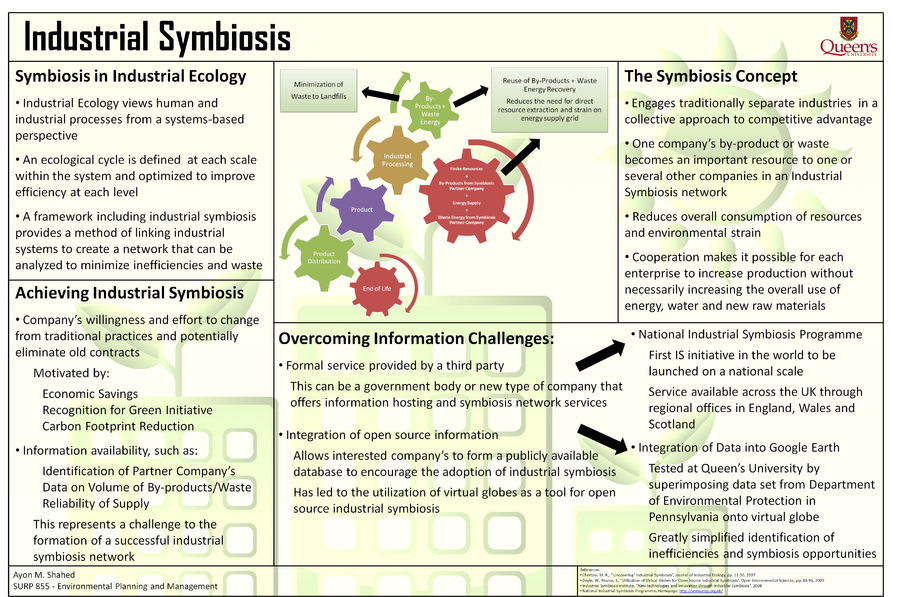
Industrial ecology encompasses design for the environment, including life cycle assessment, from product level to global level.
Industrial symbiosis[edit | edit source]
Industrial symbiosis is a subset of industrial ecology, with a particular focus on material and energy exchange.
Industrial symbiosis engages traditionally separate industries in a collective approach to competitive advantage involving physical exchange of materials, energy, water, and/or by-products. The keys to industrial symbiosis are collaboration and the synergistic possibilities offered by geographic proximity".[1] Such a system collectively optimizes material and energy use at efficiencies beyond those achievable by any individual process alone. IS systems such as the web of materials and energy exchanges among companies in Kalundborg, Denmark have spontaneously evolved from a series of micro innovations over a long time scale;[2] however, the engineered design and implementation of such systems from a macro planner's perspective, on a relatively short time scale, proves challenging. Often, access to information on available by-products is non-existent. These by-products are considered waste and typically not traded or listed on any type of exchange.

Example[edit | edit source]
Recent work reviewed government policies necessary to construct a multi-gigaWatt photovoltaic factory and complementary policies to protect existing solar companies are outlined and the technical requirements for a symbiotic industrial system are explored to increase the manufacturing efficiency while improving the environmental impact of solar photovoltaic cells. The results of the analysis show that an eight-factory industrial symbiotic system can be viewed as a medium-term investment by any government, which will not only obtain direct financial return, but also an improved global environment.[3]
Using Mapping to Assist with Industrial Symbiosis[edit | edit source]
The recent development of virtual globes such as Google Earth (GE), an information service that provides imagery and three dimensional data depicting the entire physical earth, provides an opportunity to use a new sustainable method of navigating information to save energy and use materials more efficiently in the real world. To test this open source methodology, a data set was used from the Department of Environmental Protection in Pennsylvania, which has mandated reporting the location of disposal and type of residual waste from sources producing more than one ton per month. This data set was integrated into the GE interface to identify and quantify opportunities for materials and energy efficiency improvements. This investigation found that virtual globes coupled with open source waste information can be used to[4]
- reduce embodied transport energy by reducing distances to recycling facilities,
- choose end of life at recycling facilities rather than landfills, and
- establish industrial symbiosis and eco-industrial parks on known by-product synergies.
Open source sharing of information in virtual globes provide a means to identify economically and environmentally beneficial opportunities for waste management if the data have been made available.
References
- ↑ Chertow, M. R. 2000. Industrial Symbiosis: Literature and Taxonomy, Annual Review of Energy and the Environment, 25: 313-337.
- ↑ Ehrenfeld, J. and Gertler, N. 1997. Industrial Ecology in Practice: The Evolution of Interdependence at Kalundborg, Journal of Industrial Ecology 1(1): 67.
- ↑ Pearce, J.M. 2008. "Industrial Symbiosis for Very Large Scale Photovoltaic Manufacturing", Renewable Energy 33, pp. 1101–1108. [1]
- ↑ William Doyle and Joshua M. Pearce, "Utilization of Virtual Globes for Open Source Industrial Symbiosis", Open Environmental Sciences'', 3, pp. 88-96, 2009. see:[2]
On Appropedia[edit | edit source]
See also[edit | edit source]
External links[edit | edit source]
- Industrial Ecology Wiki - very nice semantic wiki set up to follow eco-industrial parks
- Wikipedia:Industrial ecology
- There are many links at the Wikipedia article - the links here should possibly serve a different purpose?
- the most cited industrial symbiosis project is http://www.indigodev.com/Kal.html in Denmark. See also http://www.symbiosis.dk/
- http://ia311209.us.archive.org/2/items/InvestmentProductionConsumptionWasteModel/IPCW_Diagram_v3.pdf is a simple map for showing how investment, production, consumption and waste are tied together in industrial ecosystems, in a Natural Capitalism framework











